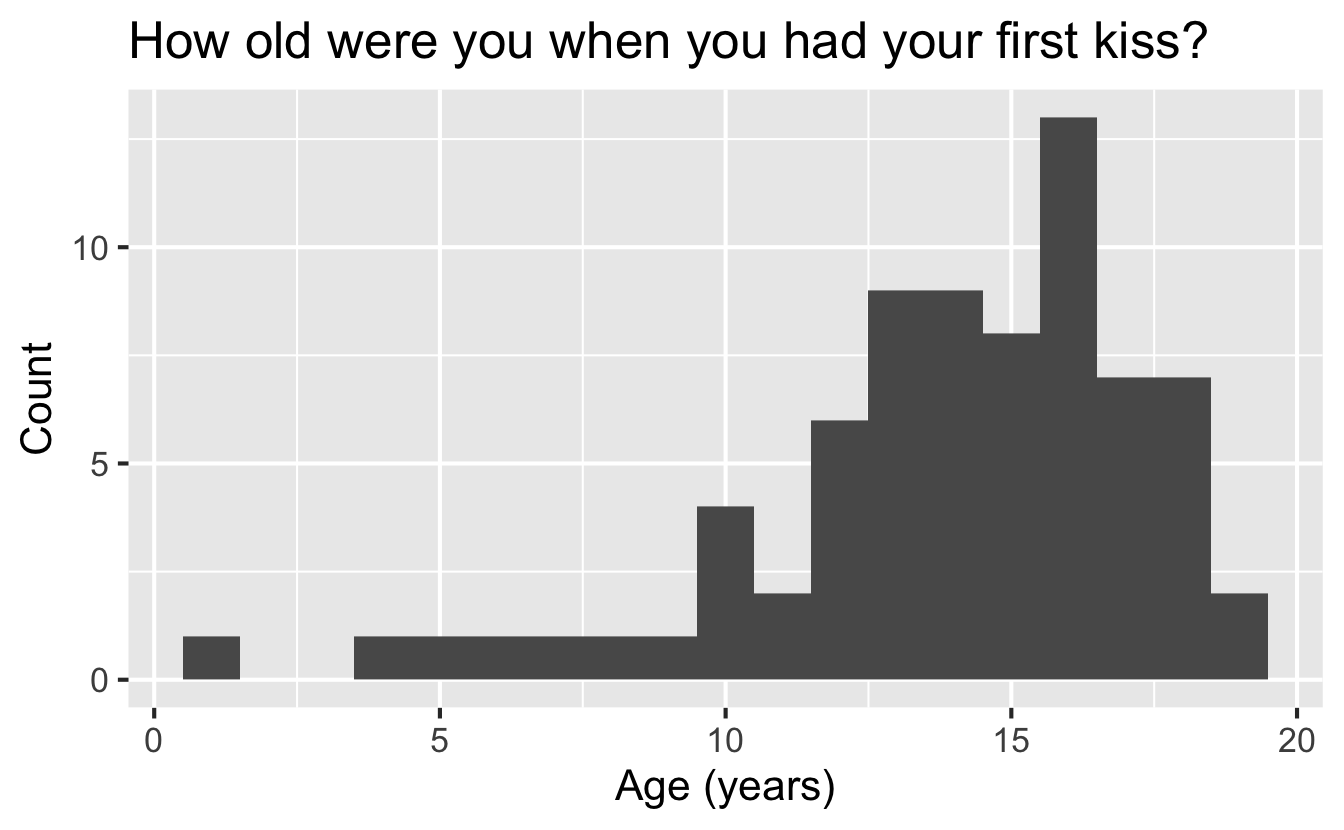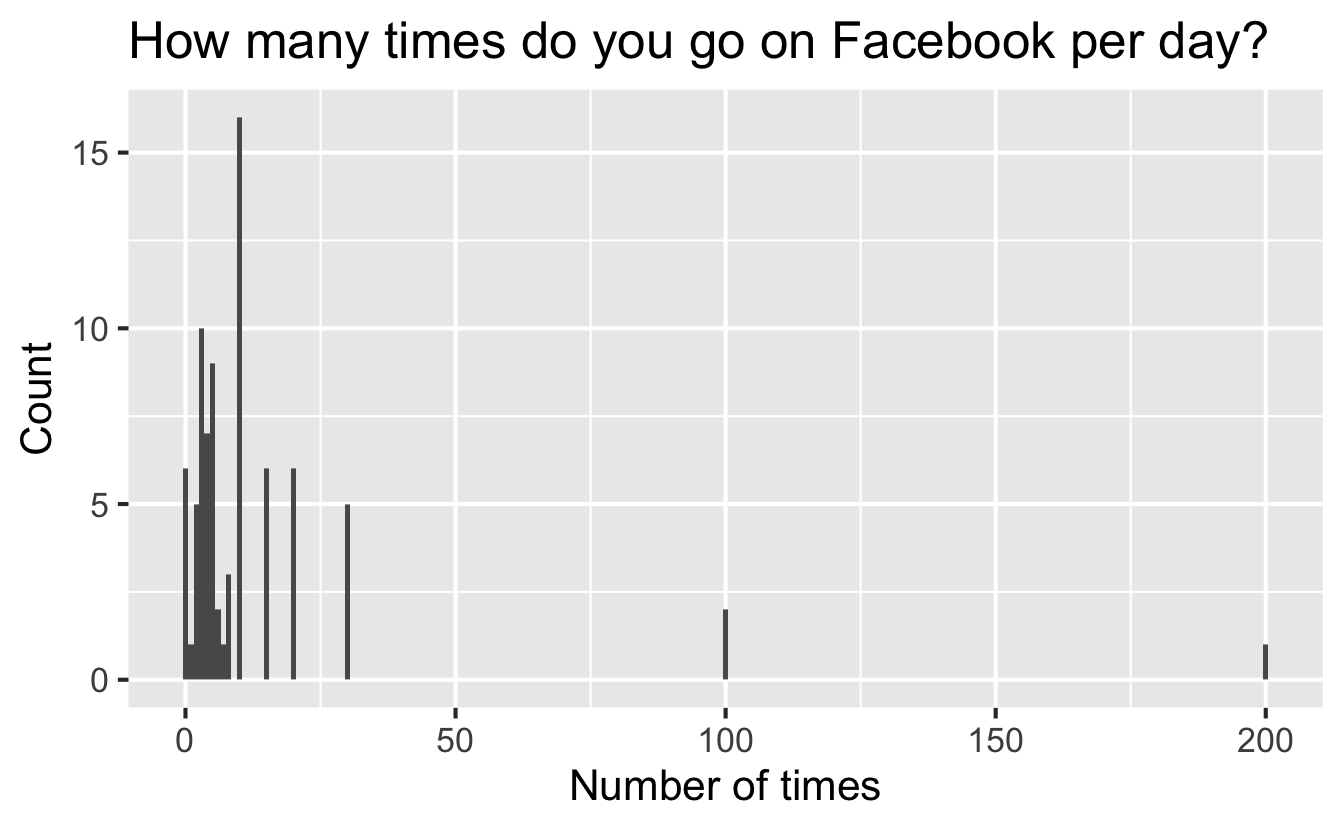# A tibble: 87 × 14
name height mass hair_color skin_color eye_color
<chr> <int> <dbl> <chr> <chr> <chr>
1 Luke Skywal… 172 77 blond fair blue
2 C-3PO 167 75 <NA> gold yellow
3 R2-D2 96 32 <NA> white, bl… red
4 Darth Vader 202 136 none white yellow
5 Leia Organa 150 49 brown light brown
6 Owen Lars 178 120 brown, gr… light blue
7 Beru Whites… 165 75 brown light blue
8 R5-D4 97 32 <NA> white, red red
9 Biggs Darkl… 183 84 black light brown
10 Obi-Wan Ken… 182 77 auburn, w… fair blue-gray
# ℹ 77 more rows
# ℹ 8 more variables: birth_year <dbl>, sex <chr>,
# gender <chr>, homeworld <chr>, species <chr>,
# films <list>, vehicles <list>, starships <list>Visualizing data
Data visualization and transformation
What is in a dataset?
Dataset terminology
- Each row is an observation
- Each column is a variable
Luke Skywalker

What’s in the Star Wars data?
Take a glimpse() at the data:
Rows: 87
Columns: 14
$ name <chr> "Luke Skywalker", "C-3PO", "R2-D2", "Da…
$ height <int> 172, 167, 96, 202, 150, 178, 165, 97, 1…
$ mass <dbl> 77, 75, 32, 136, 49, 120, 75, 32, 84, 7…
$ hair_color <chr> "blond", NA, NA, "none", "brown", "brow…
$ skin_color <chr> "fair", "gold", "white, blue", "white",…
$ eye_color <chr> "blue", "yellow", "red", "yellow", "bro…
$ birth_year <dbl> 19.0, 112.0, 33.0, 41.9, 19.0, 52.0, 47…
$ sex <chr> "male", "none", "none", "male", "female…
$ gender <chr> "masculine", "masculine", "masculine", …
$ homeworld <chr> "Tatooine", "Tatooine", "Naboo", "Tatoo…
$ species <chr> "Human", "Droid", "Droid", "Human", "Hu…
$ films <list> <"A New Hope", "The Empire Strikes Bac…
$ vehicles <list> <"Snowspeeder", "Imperial Speeder Bike…
$ starships <list> <"X-wing", "Imperial shuttle">, <>, <>…Get to know the data
How many rows and columns does this dataset have? What does each row represent? What does each column represent?
Dimensions of the data
How many rows and columns does this dataset have?
Exploratory data analysis
What is EDA?
Exploratory data analysis (EDA) is an approach for analyzing data sets to summarize their main characteristics:
- Visualize – this is what we’ll focus on first
- Summarize - this is what we’ll focus on next
- Both of these may require data wrangling, manipulation, transformation at (or before) this stage of the analysis
Mass vs. height
How would you describe the relationship between mass and height of Star Wars characters? What other variables would help us understand data points that don’t follow the overall trend? Who is the not so tall but really chubby character?

Jabba!

Data visualization
“The simple graph has brought more information to the data analyst’s mind than any other device.” — John Tukey
- Data visualization, an important part of exploratory data analysis, is the creation and study of the visual representation of data
- Many tools for visualizing data – R is one of them
- Many approaches/systems within R for making data visualizations – ggplot2 is one of them, and that’s what we’re going to use
Why visualize?
Anscombe’s quartet
set x y
1 I 10 8.04
2 I 8 6.95
3 I 13 7.58
4 I 9 8.81
5 I 11 8.33
6 I 14 9.96
7 I 6 7.24
8 I 4 4.26
9 I 12 10.84
10 I 7 4.82
11 I 5 5.68
12 II 10 9.14
13 II 8 8.14
14 II 13 8.74
15 II 9 8.77
16 II 11 9.26
17 II 14 8.10
18 II 6 6.13
19 II 4 3.10
20 II 12 9.13
21 II 7 7.26
22 II 5 4.74
23 III 10 7.46
24 III 8 6.77
25 III 13 12.74
26 III 9 7.11
27 III 11 7.81
28 III 14 8.84
29 III 6 6.08
30 III 4 5.39
31 III 12 8.15
32 III 7 6.42
33 III 5 5.73
34 IV 8 6.58
35 IV 8 5.76
36 IV 8 7.71
37 IV 8 8.84
38 IV 8 8.47
39 IV 8 7.04
40 IV 8 5.25
41 IV 19 12.50
42 IV 8 5.56
43 IV 8 7.91
44 IV 8 6.89Summarizing Anscombe’s quartet
quartet |>
group_by(set) |>
summarise(
mean_x = mean(x),
mean_y = mean(y),
sd_x = sd(x),
sd_y = sd(y),
r = cor(x, y)
)# A tibble: 4 × 6
set mean_x mean_y sd_x sd_y r
<fct> <dbl> <dbl> <dbl> <dbl> <dbl>
1 I 9 7.50 3.32 2.03 0.816
2 II 9 7.50 3.32 2.03 0.816
3 III 9 7.5 3.32 2.03 0.816
4 IV 9 7.50 3.32 2.03 0.817Visualizing Anscombe’s quartet
Age at first kiss
A group of college students were asked “How old were you when you had your first kiss?” on a survey. First, think about how you might expect the distribution of their responses to look.
Then, examine the plot below. Do you see anything out of the ordinary?

Facebook visits
Same group of college students were also asked “How many times do you go on Facebook per day?” First, think about how you might expect the distribution of their responses to look.
Then, examine the plot below. How are people reporting lower vs. higher values of FB visits?


